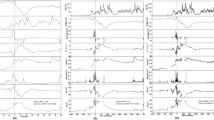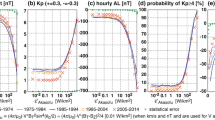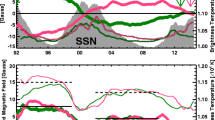Abstract
Solar Cycle 24, from December 2008 to December 2019, is recorded to be the weakest in magnitude in the space age (after 1957). A comparative study of this cycle with Solar Cycles 20 through 23 is presented. It is found that Solar Cycle 24 is not only the weakest in solar activity, but also in average solar wind parameters and solar wind–magnetosphere energy coupling. This resulted in lower geomagnetic activity, lower numbers of high-intensity long-duration continuous auroral electrojet (\(AE\)) activity (HILDCAA) events and geomagnetic storms. The Solar Cycle 24 exhibited a \(\approx 54\) – \(61\%\) reduction in HILDCAA occurrence rate (per year), \(\approx 15\) – \(34\%\) reduction in moderate storms (\(-50~\text{nT} \geq Dst > -100~\text{nT}\)), \(\approx 49\) – \(75\%\) reduction in intense storms (\(-100~\text{nT} \geq Dst > -250~\text{nT}\)) compared to previous cycles, and no superstorms (\(Dst \leq -250~\text{nT}\)). Implications of the solar and geomagnetic weakening to space weather science and operations are discussed.



Similar content being viewed by others
References
Akasofu, S.-I.: 1964, The development of the auroral substorm. Planet. Space Sci. 12, 273. DOI.
Burton, R.K., McPherron, R.L., Russell, C.T.: 1975, An empirical relationship between interplanetary conditions and \(Dst\). J. Geophys. Res. 80, 4204. DOI.
Chapman, S., Ferraro, V.C.A.: 1931, A new theory of magnetic storms. Terr. Magn. Atmos. Electr. 36, 77. DOI.
Davis, T.N., Sugiura, M.: 1966, Auroral electrojet activity index \(AE\) and its universal time variations. J. Geophys. Res. 71, 785. DOI.
Dungey, J.W.: 1961, Interplanetary magnetic field and the auroral zones. Phys. Rev. Lett. 6, 47. DOI.
Echer, E., Gonzalez, W.D., Tsurutani, B.T.: 2011, Statistical studies of geomagnetic storms with peak \(\mathrm{Dst} \leq -50~\text{nT}\) from 1957 to 2008. J. Atmos. Solar-Terr. Phys. 73, 1454. DOI.
Echer, E., Gonzalez, W.D., Gonzalez, A.L.C., Prestes, A., Vieira, L.E.A., Dal Lago, A., Guarnieri, F.L., Schuch, N.J.: 2004, Long-term correlation between solar and geomagnetic activity. J. Atmos. Solar-Terr. Phys. 66, 1019. DOI.
Echer, E., Gonzalez, W.D., Tsurutani, B.T., Gonzalez, A.L.C.: 2008, Interplanetary conditions causing intense geomagnetic storms (\(Dst < -100~\text{nT}\)) during Solar Cycle 23 (1996–2006). J. Geophys. Res. 113, 1. DOI.
Finch, I.D., Lockwood, M.L., Rouillard, A.P.: 2008, Effects of solar wind magnetosphere coupling recorded at different geomagnetic latitudes: separation of directly-driven and storage/release systems. Geophys. Res. Lett. 35, L21105. DOI.
Gonçalves, Í.G., Echer, E., Frigo, E.: 2020, Sunspot cycle prediction using warped Gaussian process regression. Adv. Space Res. 65, 677. DOI.
Gonzalez, W.D., Gonzalez, A.L.C., Tsurutani, B.T.: 1990, Dual-peak solar cycle distribution of intense geomagnetic storms. Planet. Space Sci. 38, 181.
Gonzalez, W.D., Mozer, F.S.: 1974, A quantitative model for the potential resulting from reconnection with an arbitrary interplanetary magnetic field. J. Geophys. Res. 79, 4186. DOI.
Gonzalez, W.D., Joselyn, J.A., Kamide, Y., Kroehl, H.W., Rostoker, G., Tsurutani, B.T., Vasyliunas, V.M.: 1994, What is a geomagnetic storm? J. Geophys. Res. 99, 5771. DOI.
Gonzalez, W.D., Echer, E., Tsurutani, B.T., Gonzalez, A.L., Lago, A.: 2011, Interplanetary origin of intense, superintense and extreme geomagnetic storms. Space Sci. Rev. 158, 69. DOI.
Gopalswamy, N., Nunes, S., Yashiro, S., Howard, R.A.: 2004, Variability of solar eruptions during cycle 23. Adv. Space Res. 34, 391. DOI.
Gosling, J.T., Bame, S.J., McComas, D.J., Phillips, J.L.: 1990, Coronal mass ejections and large geomagnetic storms. Geophys. Res. Lett. 17, 901. DOI.
Grandin, M., Aikio, A.T., Kozlovsky, A.: 2019, Properties and geoeffectiveness of solar wind high-speed streams and stream interaction regions during Solar Cycles 23 and 24. J. Geophys. Res. 124, 3871. DOI.
Guarnieri, F.L., Tsurutani, B.T., Vieira, L.E.A., Hajra, R., Echer, E., Mannucci, A.J., Gonzalez, W.D.: 2018, A correlation study regarding the \(AE\) index and ACE solar wind data for Alfvénic intervals using wavelet decomposition and reconstruction. Nonlinear Process. Geophys. 25, 67. DOI.
Hajra, R., Tsurutani, B.T., Lakhina, G.S.: 2020, The complex space weather events of 2017 September. Astrophys. J. 899, 3. DOI.
Hajra, R., Echer, E., Tsurutani, B.T., Gonzalez, W.D.: 2013, Solar cycle dependence of High-Intensity Long-Duration Continuous AE Activity (HILDCAA) events, relativistic electron predictors? J. Geophys. Res. 118, 5626. DOI.
Hajra, R., Echer, E., Tsurutani, B.T., Gonzalez, W.D.: 2014a, Superposed epoch analyses of HILDCAAs and their interplanetary drivers: solar cycle and seasonal dependences. J. Atmos. Solar-Terr. Phys. 121, 24. DOI.
Hajra, R., Echer, E., Tsurutani, B.T., Gonzalez, W.D.: 2014b, Solar wind-magnetosphere energy coupling efficiency and partitioning: HILDCAAs and preceding CIR storms during Solar Cycle 23. J. Geophys. Res. 119, 2675. DOI.
Ingale, M., Janardhan, P., Bisoi, S.K.: 2019, Beyond the minisolar maximum of Solar Cycle 24: declining solar magnetic fields and the response of the terrestrial magnetosphere. J. Geophys. Res. 124, 6363. DOI.
Janardhan, P., Bisoi, S.K., Gosain, S.: 2010, Solar polar fields during cycles 21 – 23: correlation with meridional flows. Solar Phys. 267, 267. DOI.
Janardhan, P., Bisoi, S.K., Ananthakrishnan, S., Tokumaru, M., Fujiki, K., Jose, L., Sridharan, R.: 2015, A 20 year decline in solar photospheric magnetic fields: inner-heliospheric signatures and possible implications. J. Geophys. Res. 120, 5306. DOI.
Janardhan, P., Fujiki, K., Ingale, M., Bisoi, S.K., Rout, D.: 2018, Solar cycle 24: an unusual polar field reversal. Astron. Astrophys. 618, A148. DOI.
Jiang, J., Cao, J.: 2018, Predicting solar surface large-scale magnetic field of cycle 24. J. Atmos. Solar-Terr. Phys. 176, 34. DOI.
Kakad, B., Kakad, A., Ramesh, D.S., Lakhina, G.S.: 2019, Diminishing activity of recent solar cycles (22 – 24) and their impact on geospace. J. Space Weather Space Clim. 9, A1. DOI.
Lamy, P.L., Floyd, O., Boclet, B., Wojak, J., Gilardy, H., Barlyaeva, T.: 2019, Coronal mass ejections over Solar Cycles 23 and 24. Space Sci. Rev. 215, 39. DOI.
Livingston, W., Penn, M.J., Svalgaard, L.: 2012, Decreasing sunspot magnetic fields explain unique 10.7 cm radio flux. Astrophys. J. 757, L8. DOI.
Marques de Souza, A., Echer, E., Bolzan, M.J.A., Hajra, R.: 2018, Cross-correlation and cross-wavelet analyses of the solar wind IMF \(B_{Z}\) and auroral electrojet index AE coupling during HILDCAAs. Ann. Geophys. 36, 205. DOI.
Mendes, O., Domingues, M.O., Echer, E., Hajra, R., Menconi, V.E.: 2017, Characterization of high-intensity, long-duration continuous auroral activity (HILDCAA) events using recurrence quantification analysis. Nonlinear Process. Geophys. 24, 407. DOI.
Nakagawa, Y., Nozawa, S., Shinbori, A.: 2019, Relationship between the low-latitude coronal hole area, solar wind velocity, and geomagnetic activity during Solar Cycles 23 and 24. Earth Planets Space 71, 24. DOI.
Obridko, V.N., Ivanov, E.V., Özgüç, A., Kilcik, A., Yurchyshyn, V.B.: 2012, Coronal mass ejections and the index of effective solar multipole. Solar Phys. 281, 779. DOI.
Ohtani, S.: 2001, Substorm trigger processes in the magnetotail: recent observations and outstanding issues. Space Sci. Rev. 95, 347. DOI.
Perreault, P., Akasofu, S.-I.: 1978, A study of geomagnetic storms. Geophys. J. Roy. Astron. Soc. 54, 547. DOI.
Richardson, I.G., Cane, H.V., Cliver, E.W.: 2002, Sources of geomagnetic activity during nearly three solar cycles (1972 – 2000). J. Geophys. Res. 107, SSH 8-1. DOI.
Rostoker, G.: 1972, Geomagnetic indices. Rev. Geophys. 10, 935. DOI.
Sasikumar Raja, K., Janardhan, P., Bisoi, S.K., Ingale, M., Subramanian, P., Fujiki, K., Maksimovic, M.: 2019, Global solar magnetic field and interplanetary scintillations during the past four solar cycles. Solar Phys. 294, 123. DOI.
Scolini, C., Messerotti, M., Poedts, S., Rodriguez, L.: 2018, Halo coronal mass ejections during Solar Cycle 24: reconstruction of the global scenario and geoeffectiveness. J. Space Weather Space Clim. 8, A09. DOI.
Shue, J.-H., Chao, J.-K.: 2013, The role of enhanced thermal pressure in the earthward motion of the Earth’s magnetopause. J. Geophys. Res. 118, 3017. DOI.
Souza, A.M., Echer, E., Bolzan, M.J.A., Hajra, R.: 2016, A study on the main periodicities in interplanetary magnetic field Bz component and geomagnetic AE index during HILDCAA events using wavelet analysis. J. Atmos. Solar-Terr. Phys. 149, 81. DOI.
Sugiura, M.: 1964, Hourly values of equatorial Dst for the IGY. Ann. Int. Geophys. Year 35, 9.
Syed Ibrahim, M., Joshi, B., Cho, K.-S., Kim, R.-S., Moon, Y.-J.: 2019, Interplanetary coronal mass ejections during Solar Cycles 23 and 24: Sun–Earth propagation characteristics and consequences at the near-Earth region. Solar Phys. 294, 54. DOI.
Tsurutani, B.T., Echer, E., Gonzalez, W.D.: 2011, The solar and interplanetary causes of the recent minimum in geomagnetic activity (MGA23): a combination of mid latitude small coronal holes, low IMF \(B_{Z}\) variances, low solar wind speeds and low solar magnetic fields. Ann. Geophys. 29, 839. DOI.
Tsurutani, B.T., Gonzalez, W.D.: 1987, The cause of high-intensity long-duration continuous \(AE\) activity (HILDCAAs): interplanetary Alfvén wave trains. Planet. Space Sci. 35, 405. DOI.
Tsurutani, B.T., Lakhina, G.S., Hajra, R.: 2020, The physics of space weather/solar-terrestrial physics (STP): what we know now and what the current and future challenges are. Nonlinear Process. Geophys. 27, 75. DOI.
Tsurutani, B.T., Meng, C.-I.: 1972, Interplanetary magnetic-field variations and substorm activity. J. Geophys. Res. 77, 2964. DOI.
Tsurutani, B.T., Gonzalez, W.D., Tang, F., Akasofu, S.I., Smith, E.J.: 1988, Origin of interplanetary southward magnetic fields responsible for major magnetic storms near solar maximum (1978 – 1979). J. Geophys. Res. 93, 8519. DOI.
Tsurutani, B.T., Gonzalez, W.D., Tang, F., Lee, Y.T.: 1992, Great magnetic storms. Geophys. Res. Lett. 19, 73. DOI.
Tsurutani, B.T., Gonzalez, W.D., Gonzalez, A.L.C., Guarnieri, F.L., Gopalswamy, N., Grande, M., Kamide, Y., Kasahara, Y., Lu, G., Mann, I., McPherron, R., Soraas, F., Vasyliunas, V.: 2006, Corotating solar wind streams and recurrent geomagnetic activity: a review. J. Geophys. Res. 111, A07S01. DOI.
Tsurutani, B.T., Hajra, R., Echer, E., Lakhina, G.S.: 2019, Comment on “First observation of mesosphere response to the solar wind high-speed streams” by W. Yi et al. J. Geophys. Res. 124, 8165. DOI.
Upton, L.A., Hathaway, D.H.: 2018, An updated Solar Cycle 25 prediction with AFT: the modern minimum. Geophys. Res. Lett. 45, 8091. DOI.
Wang, Y.-M.: 2017, Surface flux transport and the evolution of the Sun’s polar fields. Space Sci. Rev. 210, 351. DOI.
Webb, D.F., Howard, R.A.: 1994, The solar cycle variation of coronal mass ejections and the solar wind mass flux. J. Geophys. Res. 99, 4201. DOI.
Acknowledgements
The work is funded by the Science and Engineering Research Board (SERB), a statutory body of the Department of Science and Technology (DST), Government of India through a Ramanujan Fellowship. I would like to thank Prof. Bruce T. Tsurutani for helpful scientific discussions. I also thank the reviewer for extremely valuable suggestions that substantially improved the manuscript.
Author information
Authors and Affiliations
Corresponding author
Ethics declarations
Disclosure of Potential Conflicts of Interest
The author declares that he has no conflicts of interest.
Additional information
Publisher’s Note
Springer Nature remains neutral with regard to jurisdictional claims in published maps and institutional affiliations.
Rights and permissions
About this article
Cite this article
Hajra, R. Weakest Solar Cycle of the Space Age: A Study on Solar Wind–Magnetosphere Energy Coupling and Geomagnetic Activity. Sol Phys 296, 33 (2021). https://doi.org/10.1007/s11207-021-01774-9
Received:
Accepted:
Published:
DOI: https://doi.org/10.1007/s11207-021-01774-9




